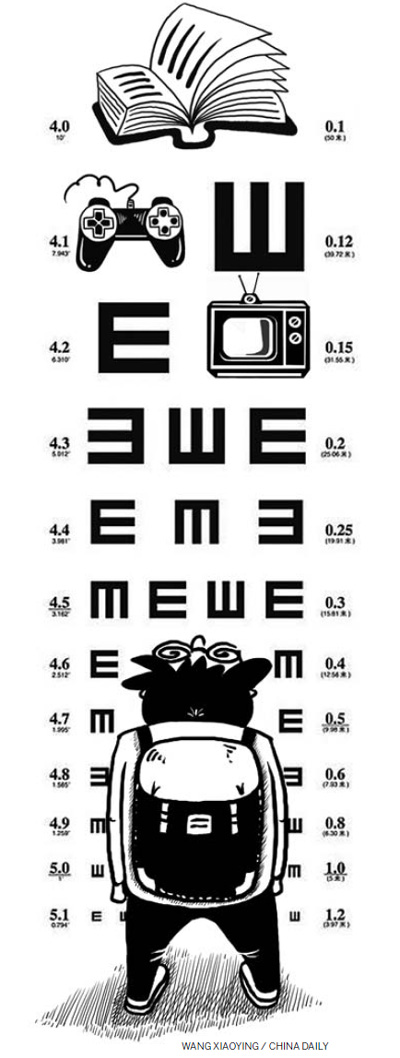Op-Ed Contributors
Saving children from a myopic world
By Fumiyo Layman (China Daily)
Updated: 2010-09-17 07:42
 |
Large Medium Small |

When I was a child, my parents would tell me: You have only two eyes don't damage them by reading in a dark or dimly lit room or sitting too close to the TV screen.
Today, I am telling the same thing to my two small children.
Children today spend more time staring at computer and TV screens both at school and home. Scientific studies show an epidemic of myopia (also known as nearsightedness) has struck children - and it is spreading faster in many countries. Doctors warn that sitting too close to a computer, especially fixing your eyes at a computer or TV screen from close range, increases the risk of myopia.
The cause of myopia is difficult to explain in simple terms. While some say sitting near computers and TV screens is one of the reasons, others say children born to nearsighted parent/parents are more vulnerable.
Can genes or the environment, or a combination of the two explain the growing prevalence of myopia across many countries? How can parents understand what causes myopia and the risks it poses to their children's eyesight?
Children suffering from myopia have trouble seeing distant objects clearly. The eyeball is thought to become longer, because of which less effort is needed to see up close. But the elongated eye can no longer focus on distant objects.
Symptoms of myopia are usually noticed in early childhood. Myopic children may hold books very close to their face or may not be able to read the writing on the blackboard in school. They may squint and complain of headaches and eyestrain.
A study conducted by the Archives of Ophthalmology in December 2009 shows the rate of myopia in the United States increased from 25 percent in the early 1970s to 41.6 percent in 1999-2004. Although this survey did not focus on children, it is clear that myopia among them has increased significantly in the last three decades.
Japan, too, has a large number of myopic children. According to a 2008 survey of the Japanese Ministry of Education and Science, 28.9 percent of kindergarten and primary school children in the country have myopia. When it comes to junior and high school students, the percentage rises up to 58. Surveys in Singapore and South Korea have thrown up similar results.
"Poor eyesight definitely runs in families," says Barry Starr, of Stanford University. "Recent studies have shown that if both your parents are shortsighted, then you have about a 1 in 3 chance of being shortsighted. If only one of your parents is shortsighted, then you have a 1 in 5 chance of being shortsighted. If neither of your parents is shortsighted, then you have less than a 1 in 40 chance".
A study conducted by Abhishek Sharma, of Oxford University, shows that up to 60 percent rural Chinese children need glasses, but most either do not have them or do not wear them even if they do. If this research is correct, Chinese parents need to be more vigilant about their children's eyesight, especially if both of them are shortsighted.
Many doctors and educators believe that the environment plays a key role in the deterioration of children's eyesight.
"The theory is that the amount of near work (sitting very close to computers) may stimulate children to have more shortsightedness because the eye changes shape to focus more clearly on things up close", says Roy Chuk, of the Albert Einstein College of Medicine in the US.
For better eyesight, doctors suggest to limit the hours of screen time and encourage having sufficient eye resting time.
Yet another study argues that staying glued to computer or TV screens for long hours is not the sole environmental cause of myopia. An Australian research team compared the prevalence of and risk factors for myopia among young children of Chinese origin in Sydney and Singapore (Archives of Ophthalmology in 2008).
The study concluded that the prevalence of myopia among children in Sydney was lower than their counterparts in Singapore, even though they spent more time in front of computer and TV screens. The major finding is that children in Sydney spend longer hours on outdoor activities than those in Singapore.
Indoors and outdoors sports activities both make the eyes focus on more distant objects, which prevents the eye from changing shape. But outdoor activities may help escape myopia more significantly than indoor sports activities.
Jane Gwiazda, a psychologist from New England College of Optometry in Boston, US, who conducts research in vision problems, says: "Natural light might stimulate dopamine production, which is known to inhibit eye growth. And extra vitamin D from the sun might contribute to regulating eye growth".
Many ophthalmologists recommend that every child get its first eye test done when he/she is about two and half years old, and even if his/her vision seems perfect.
It is necessary for myopic children to wear glasses to prevent headache, trouble reading or injuries. It is also important that schools invite specialists to test their students' eyes.
If that is not possible, school authorities should at least encourage parents and children to have regular eye checkups and wear glasses as prescribed. And parents should remember not only to limit the total screen time for their children, but also to encourage them to spend time outdoors.
The author is a freelance writer from Japan.
(China Daily 09/17/2010 page9)